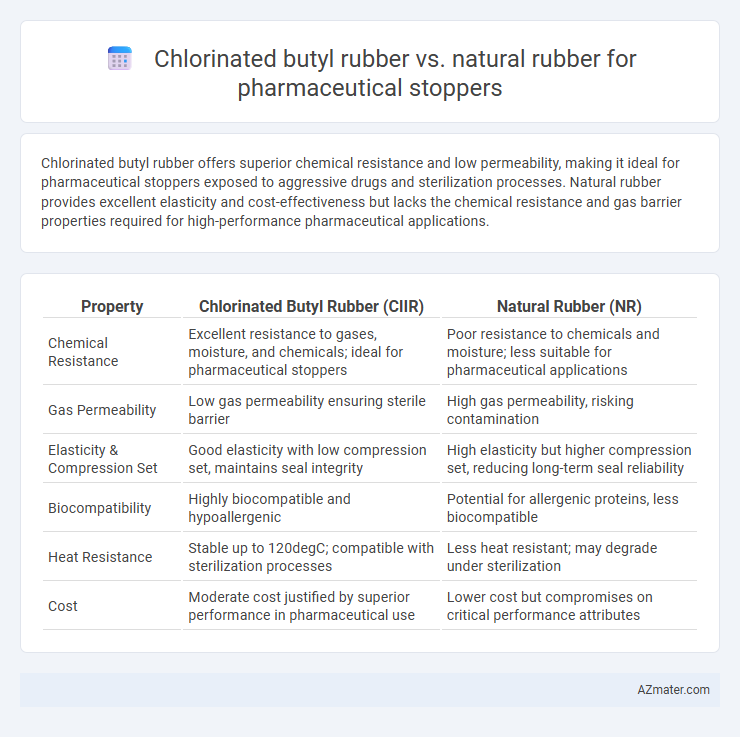Chlorinated butyl rubber offers superior chemical resistance and low permeability, making it ideal for pharmaceutical stoppers exposed to aggressive drugs and sterilization processes. Natural rubber provides excellent elasticity and cost-effectiveness but lacks the chemical resistance and gas barrier properties required for high-performance pharmaceutical applications.
Table of Comparison
| Property | Chlorinated Butyl Rubber (CIIR) | Natural Rubber (NR) |
|---|---|---|
| Chemical Resistance | Excellent resistance to gases, moisture, and chemicals; ideal for pharmaceutical stoppers | Poor resistance to chemicals and moisture; less suitable for pharmaceutical applications |
| Gas Permeability | Low gas permeability ensuring sterile barrier | High gas permeability, risking contamination |
| Elasticity & Compression Set | Good elasticity with low compression set, maintains seal integrity | High elasticity but higher compression set, reducing long-term seal reliability |
| Biocompatibility | Highly biocompatible and hypoallergenic | Potential for allergenic proteins, less biocompatible |
| Heat Resistance | Stable up to 120degC; compatible with sterilization processes | Less heat resistant; may degrade under sterilization |
| Cost | Moderate cost justified by superior performance in pharmaceutical use | Lower cost but compromises on critical performance attributes |
Introduction to Pharmaceutical Stoppers
Pharmaceutical stoppers require materials with exceptional chemical resistance and durability to maintain drug integrity. Chlorinated butyl rubber offers superior impermeability and resistance to sterilization processes compared to natural rubber, making it ideal for stopper applications. Natural rubber, while flexible and cost-effective, lacks the barrier properties essential for preventing contamination in pharmaceutical packaging.
Overview of Chlorinated Butyl Rubber
Chlorinated butyl rubber (CIIR) is a synthetic elastomer known for its excellent chemical resistance, low permeability to gases, and high impermeability, making it ideal for pharmaceutical stoppers requiring stringent contamination control. Compared to natural rubber, CIIR offers superior resistance to heat, ozone, and a wide range of chemicals, enhancing the durability and shelf life of pharmaceutical products. Its unique molecular structure contributes to reduced extractables and improved sealing properties critical in maintaining drug sterility and efficacy.
Overview of Natural Rubber
Natural rubber is a biopolymer derived from the latex of Hevea brasiliensis trees, widely used in pharmaceutical stoppers due to its excellent elasticity, resilience, and sealing properties. It offers superior compatibility with a variety of pharmaceuticals, ensuring tight seals and preventing contamination or leakage. Despite its natural origin, advancements in purification and processing techniques have enhanced its chemical resistance and reduced allergenic proteins, making it a preferred choice for stopper applications in the medical and pharmaceutical industries.
Key Material Properties Comparison
Chlorinated butyl rubber offers superior chemical resistance and low permeability to gases, making it ideal for pharmaceutical stoppers requiring extended shelf life and sterility. Natural rubber provides excellent elasticity and high tensile strength but has poorer resistance to solvents and gases, limiting its use in stringent pharmaceutical environments. The low extractables and inertness of chlorinated butyl rubber ensure minimal interaction with drug formulations compared to natural rubber.
Chemical Resistance and Compatibility
Chlorinated butyl rubber demonstrates superior chemical resistance and compatibility compared to natural rubber, making it ideal for pharmaceutical stoppers exposed to a wide range of drug formulations, including aggressive solvents and acidic or alkaline solutions. Its low permeability to gases and excellent resistance to oils, alcohols, and other chemicals ensure product integrity and prevent contamination during storage. Natural rubber, while providing good elasticity and sealing properties, is more susceptible to degradation from chemical attack, limiting its use in pharmaceutical applications with harsh chemical environments.
Air Tightness and Permeability
Chlorinated butyl rubber offers superior air tightness and lower gas permeability compared to natural rubber, making it ideal for pharmaceutical stoppers requiring enhanced barrier properties. Its chemical resistance also reduces the risk of contamination and maintains sterility over extended storage periods. In contrast, natural rubber exhibits higher permeability and lower resistance to air ingress, potentially compromising the integrity of pharmaceutical products.
Extractables and Leachables Profile
Chlorinated butyl rubber exhibits a superior extractables and leachables profile compared to natural rubber, showing lower permeation and fewer chemical contaminants, which enhances pharmaceutical product safety and integrity. Its chemically inert nature minimizes the risk of leachables migrating into drug formulations, meeting stringent regulatory requirements for parenteral drug packaging. Natural rubber tends to have higher levels of extractables due to its complex protein and additive composition, potentially increasing the risk of patient exposure to unwanted compounds.
Impact on Drug Stability
Chlorinated butyl rubber offers superior chemical resistance and low gas permeability compared to natural rubber, significantly reducing drug contamination and maintaining pharmaceutical stability. Natural rubber, while highly elastic, is more prone to extractables and interactions with drug components, potentially compromising drug integrity over time. Using chlorinated butyl rubber for pharmaceutical stoppers ensures enhanced drug shelf-life by minimizing leachables and preserving the drug's active ingredients.
Regulatory Acceptance and Compliance
Chlorinated butyl rubber is widely favored in pharmaceutical stoppers due to its superior chemical inertness and enhanced regulatory acceptance, meeting stringent FDA and USP standards for drug compatibility and extractables. Natural rubber, while offering excellent elasticity, faces challenges with allergenic proteins and higher extractable content, often requiring additional processing to comply with regulatory guidelines. Compliance with ISO 10993 biocompatibility standards is more consistently achieved with chlorinated butyl rubber, making it the preferred choice for parenteral drug packaging.
Conclusion: Optimal Choice for Pharmaceutical Stoppers
Chlorinated butyl rubber offers superior chemical resistance, low permeability, and excellent sealing properties compared to natural rubber, making it the optimal choice for pharmaceutical stoppers. Its enhanced compatibility with a wide range of drug formulations ensures long-term stability and prevents contamination. Natural rubber, while more elastic, lacks the chemical inertness necessary for sensitive pharmaceutical applications.

Infographic: Chlorinated butyl rubber vs Natural rubber for Pharmaceutical stopper
 azmater.com
azmater.com